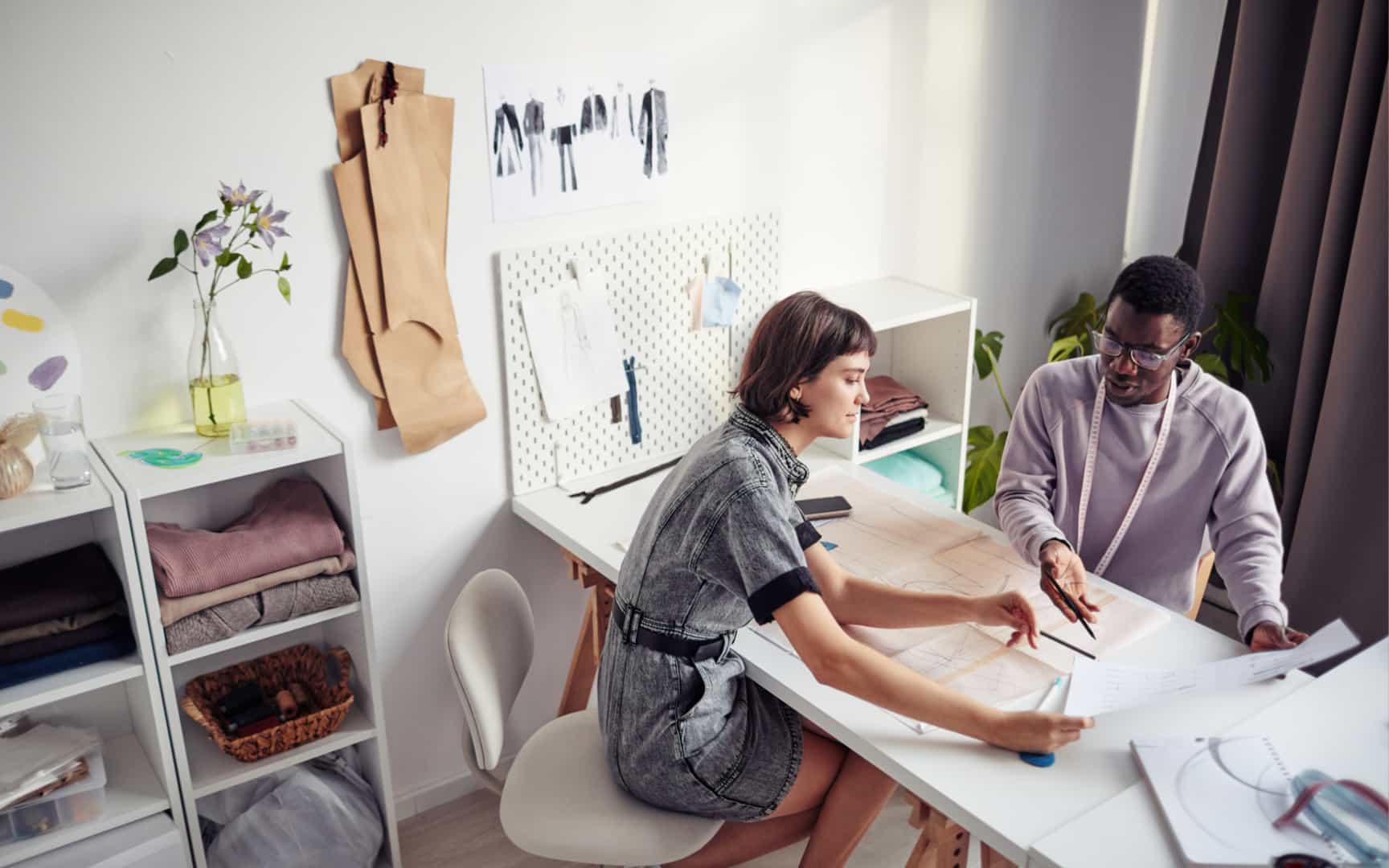They say you shouldn’t judge a book by its cover. But with branding, the cover is pretty darn important. You’re competing with hundreds of thousands of other companies for your target audience’s time and money. So, you need to grab their attention.
It’s easy to get branding design wrong. Your color scheme might just be the ones you liked the look of best. But did you know your choice should be based on psychology? Or that there are certain trademarked colors that are off-limits?
This article will answer “What is branding design?” and how to effectively use it to form your brand identity. It’ll cover the most important elements to work on, along with real-world examples for each.
Key takeaways
- A strong brand design can increase brand recognition to build trust and credibility, appeal to your target audience to attract new customers, and improve customer loyalty and retention.
- Nike’s logo originally cost them $35. Pepsi’s logo cost $1 million, while Coca-Cola’s (largely unchanged since 1886) was designed by the founder’s bookkeeper for free.
- Research has shown that a signature color can cause an 80% increase in a consumer’s brand recognition.
- Typography is the way text is arranged to be visually appealing to readers. Typeface is the particular design style applied to letters and characters, and fonts are the different styles applied to typefaces (italics, bold, black, etc.)
- When used properly, your choice of imagery can deepen a customer or prospect’s attachment to your brand. Whether it’s a highway billboard or a square on your Instagram feed, it’s your chance to visually communicate what you offer.
What is branding design?
Your branding design shapes the way the world perceives your company—both the look and feel. Whether you’re an entrepreneur building a brand from scratch or an established one that’s rebranding, you want to appeal to a certain audience.
Branding design is the visual representation that makes your brand recognizable. This includes potential customer touchpoints like:
- Product packaging
- Web design
- Social media profiles
- Commercials and ads
- App design
- Business cards
It should be based on the brand personality you’re trying to create. And each choice of shape or pattern has to be backed up by market research and data.
How does design impact your brand identity?
Ask yourself, what does your brand stand for? The answer will stem from your core beliefs and mission. Maybe it’s to save sea turtles or build toilets in third-world countries. Either way, your brand identity is made up of lots of factors, including:
- Brand name
- Tagline
- Story and brand values
- Tone of voice
- Initiatives (like sustainability promises or charitable efforts)
A strong brand has a synergy between all of these elements. It appeals to specific audiences who can instantly recognize it on any platform. Mercedes and Dodge both sell cars, but their brand identities are very different.
One’s ad design is silver, sleek, and elegant. The other is big, bold, and red. It’s obvious they’re aiming at different types of customers.


Brand design doesn’t just apply to companies, either. Personal brands can go through the same transformation.
The evolution of Miley Cyrus from a Disney child star to the Joan-Jett-esque style she has now is a branding choice. It shows the direction she wants her career to take and the genre of music she wants to be known for.

Now, a lot of this is simply due to her growing up. But it’s a good visual representation of the effect design (in this case, hair, make-up, and clothing) can have on your perception of a person.
The benefits of strong brand design
Your brand style will likely change as you evolve. Sometimes, this won’t go down so well. When Gap tried to change their signature logo and typeface, the immediate negative backlash from consumers meant they quickly backtracked.

A strong brand design can impact your company in so many positive ways:
- Increases brand recognition to build trust and credibility
- Appeals to your target audience to attract new customers
- Improves customer loyalty and retention
- Results in positive word-of-mouth marketing
- Makes more people want to work for your company
To keep on track of everything, organized companies create brand guidelines or style guides. They can be as simple or detailed as you like. But they’ll cover the fundamentals to keep your whole team on the same page.

Now, what are the main visual elements that your style guide should cover?
6 brand design elements for visual identity
Your brand design represents your company through imagery—whether you’re a young, fresh startup or a trusted, established corporation. When putting together your visual branding strategy, you’ll want to focus on these six key elements:
- Logo design
- Color palette
- Typography
- Shapes
- Graphic design imagery
- Animation and motion
1. Logo design
When you hear a brand name, what’s the first thing you think of about that brand? I’m guessing it’s something that includes the logo or wordmark.
Nike has one of the world’s most recognizable logos. Created in 1971 by designer Carolyn Davidson, she was paid just $35 for her 17.5 hours of work. Later, she acquired around 500 shares in the company. Phew.

It’s often misinterpreted as a simple tick. But the Nike “Swoosh” uses curves and arches to portray speed, movement, and action—based on the Greek goddess of victory the company was named after.

Brand logos appear in every industry, from music to sports. And a good one can transcend genres to become mainstream.


Your brand logo is one of the most valuable assets in your brand design. But how much value would you place on its creation?
While Nike’s price was $35, Pepsi’s logo cost them $1 million. (I know, I know. We should have taken art in school.)

But $1 million is small change compared to BP, who spent $211 million on their rebranded logo in 2008. So, how about Pepsi’s main competitor? Well, Coca-Cola’s (largely unchanged since 1886) was designed by the founder’s bookkeeper for free.
However much you choose to spend, the trust and credibility a solid logo earns you can almost become priceless. So, make sure you put a lot of thought and time into the design process.
2. Color palette
Colors are the foundation of brand design, and you shouldn’t choose yours lightly. It’s not just about aesthetics. It’s the effect they can have on consumers’ moods.
Color psychology plays a huge role in marketing. Most of the time, without any of us realizing. Humans make decisions based on emotion rather than logic. We just do. And the colors of your brand image can have a huge impact.
Here are some of the color associations with different emotions to consider in your branding process:
| Red | Love, passion, energy, excitement, anger |
| Orange | Optimism, enthusiasm, youth, pleasure, freedom |
| Yellow | Joy, positivity, warmth, fun, curiosity |
| Green | Nature, health, prosperity, luck, safety |
| Blue | Success, trust, security, confidence, purpose |
| Purple | Imagination, fantasy, royalty, mystery, justice |
| Pink | Softness, respect, femininity, gratitude, creativity |

Research has shown that a signature color can cause an 80% increase in a consumer’s brand recognition. When Dunkin’ Donuts rebranded to just Dunkin’ a few years ago, you can bet they kept their signature colors.

Understanding your brand’s personality
Choosing your color palette means having a clear understanding of your brand’s personality. Only then can you communicate that personality through color.
Try to choose a few key words and phrases that describe your core values. Then use these to determine the colors associated with them.

Color psychology does impact purchasing behavior. But that doesn’t mean you need to follow the norm. Blue is a common color palette for the tech and finance industry as it feels trustworthy and secure. That’s probably why nearly 40% of Fortune 500 companies use blue in their logo.
So, it’s no wonder PayPal have gone for the same as they’re dealing with your digital money. But why then have MasterCard gone for fiery red and orange? Perhaps to make them stand out as a more energetic, youthful brand.

Some brands are so protective of their brand colors that they’ve trademarked them. Did you know you could get sued for using Tiffany Blue or Barbie Pink? Yikes.
On a lighter note, we’ll finish with a game. How many of these brand color schemes can you guess?

3. Typography
Before we dive in, there are three terms used interchangeably on this topic that actually have different meanings:
- Typography: The way text is arranged to be visually appealing to readers
- Typeface: The particular design style applied to letters and characters
- Font: The different styles applied to typefaces (italics, bold, black, etc.)

So, brand typography isn’t just about the font you choose. It’s more than that. It involves:
- Size
- Spacing
- Capitalization
- Contrast
- Color
- White/negative space
So many brands are known more for their typography than color palette. Could you imagine the McDonald’s ‘M’ looking any different? That’s also why Gap’s attempt to change theirs failed miserably.

Like colors, fonts can be broken down into six main categories—each with associated personalities:
| Serif | Classic, traditional, trustworthy |
| Sans-Serif | Modern, minimal, clean |
| Slab-Serif | Bold, quirky, confident |
| Script | Elegant, unique |
| Handwritten | Informal, artistic |
| Decorative | Stylized, distinctive, dramatic |

Usually, a brand’s logo will stick to the one font:


But contrast creates interest. So, most brands use two or three typefaces in their digital marketing strategies. Any more than that, and it could be too busy or confusing for readers.

So, choose your fonts wisely. If you do your job well, you could be looking at them for a long time.
4. Shapes
Shapes have a huge part to play in logo design. Because (you guessed it) there are psychological and subconscious associations behind them.
- Circles suggest warmth, community, and inclusion: Softer and more welcoming, these create emotional connections that can be beneficial for charitable or educational industries.
- Squares suggest strength, courage, and security: They are used in industries where trust and loyalty are essential (like insurance, finance, or tech).
- Triangles suggest excitement, innovation, and growth: These are less popular than squares or circles but can feel powerful and unique because of it.
- We can also subconsciously associate vertical lines with masculinity and strength and horizontal lines with community, tranquility, and calm.

While you might have thought about this when designing your logo, have you ever considered using shapes as part of your wider brand design? You can use shapes as part of a layout to:
- Symbolize ideas or concepts
- Set a mood or suggest emotion
- Encourage a path for the eye to travel around the design
- Create depth or movement
- Connect text and imagery

Beamery’s choice of hexagonal logo is certainly unique. From another angle, it’s a 3D square. And with a tagline like “Talent Agility for a Changing World”, you can see why they want to be different.

It takes the trustworthy, secure square into the future. And this shape is seen throughout their site. Sometimes, it’s more obvious:

Other times, less so:

Sometimes, you’d barely know it was there at all:

Beamery is a great example of how to carry shapes throughout your site and into your brand identity design. Just how creative you can get with this theory is down to you.
5. Graphic design imagery
Brand imagery has to communicate the right message to your target audience. What does your beverage taste like? What does the jacket feel like when you wear it?
When used properly, your choice of imagery can deepen a customer or prospect’s attachment to your brand. Whether it’s a highway billboard or a square on your Instagram feed, it’s your chance to visually communicate what you offer.
The main popular categories of imagery are:
- Photography: The most-used real-life form of brand design imagery.
- Videography: Usually used in tandem with photography to show a product or service in action.
- Illustration: Can range from stand-alone drawings to overlays on photographs or videos.
- Iconography: Small symbols that visually represent specific actions or functions.
- Patterns and textures: A repeated decorative design or the appearance of consistency.
- 3D graphic design: An object within a three-dimensional space usually created with computer-modeling software.

According to Elementor, these are some of the benefits we can expect when we put time into defining our brand imagery:
- Our visuals become just as recognizable as our name or logo
- The unique style sets our brand apart from the competition
- We leave prospects with a memorable impression at every touchpoint
- We can tell our story without having to use words
- Our design choices have positive associations for our audience
How to choose the right style for your brand
But which is the right style for your brand? Like all of the other elements, break down the description of your business into a few words. Look at other examples of websites that share these terms.
You’re not looking to copy anyone, but it can give you a good idea of how they’ve represented themselves. You might choose to use a similar style of photography. Or go the complete opposite way, like Lemonade insurance.
How do you shake up an industry that’s been virtually unchanged for centuries? Some childlike drawings and hot pink accents should do the trick.

You have to think about the reaction you want from your audience. Are you a fresh, innovative company like Reuben’s Brews? Their site is big and bold, but minimal. There’s a sharp shot of an ice-cold pint of beer with plenty of white space to draw your attention to the important text.

Lemon.io is at the other end of the scale with their imagery. The pitch-black background accentuates the neon colors and whimsical illustrations as you search for “the almighty devs”.

Choosing the right imagery for your brand design has to be based on research. Look at your own company and the story you want to tell. Then use examples of other brands in your industry to help you align or contrast.
6. Animation and motion
The final brand element that can impact your image isn’t used all the time. But it’s growing in popularity and can elevate a good brand design to a great one. Using animation and motion is an advanced design technique that can highlight your brand as a cutting-edge company.
There are hundreds of use cases, but here are some popular ones:
- Visual feedback that an action has been successful (e.g. a number popping up to show how many items are in a user’s shopping cart)
- Loading screens for bigger sites to keep users engaged and lower bounce rate
- Hover screens that tell a user something is clickable
- Livening up a navigation menu to help your site stand out from others

It can hold a user’s attention for longer than a static web page, but it needs to be carefully designed to ensure it isn’t distracting or confusing. The bottom line: don’t just use animation for the sake of it.
Motion should be used to enhance the user experience (UX). It can be as simple as making a button flash or as complex as a full gaming experience.

One of the most important elements of animation is timing. If it’s too fast, it could be missed. Too slow, and the user may assume there’s a problem with the site.
You need to find out how any animation will impact UX before committing. Toptal recommends a few steps:
- Examine your existing website design
- Find out the hardware platforms your target audience uses
- Check the site load times and CPU (central processing unit) load
- Explore other alternatives
- Keep an eye on usability

Animation and motion can elevate your brand design and user experience. It can make your site more dynamic, fluid, and just plain interesting. But only if applied meaningfully.
Conclusion
It really comes down to one question. What kind of visual brand story do you want to tell? Figuring out the answer means diving into what your company stands for and the ways you’d describe your brand—then using this information to steer yourself in the right direction.
Combine this with looking at examples of other brands as templates for success. Then take all this evidence (or hand it to a talented designer) to create a unique, memorable, and powerful brand design that shows people who you are and what you’re going to achieve.
What is your brand mission or overarching goal? Can you think of three words to describe your business right now? Using the answers to these questions can help you tweak your brand design to better align with your target audience.





